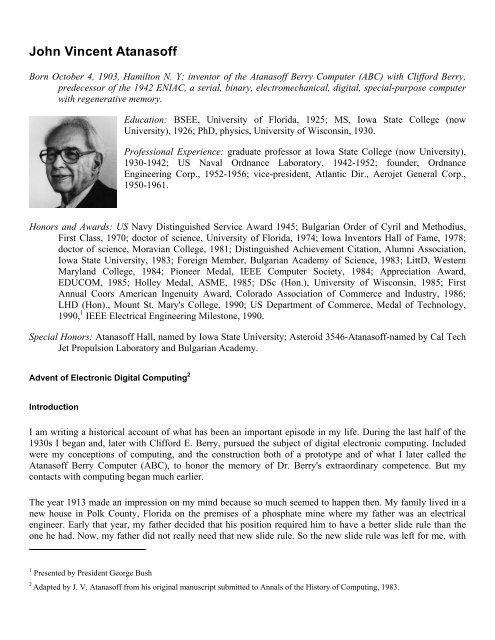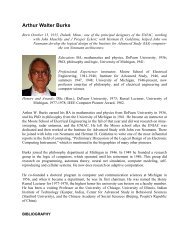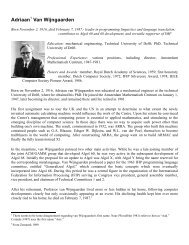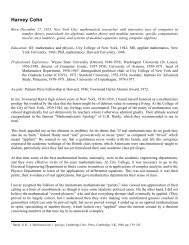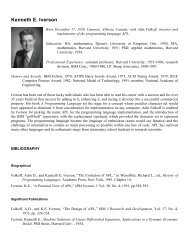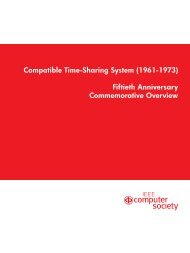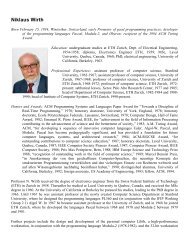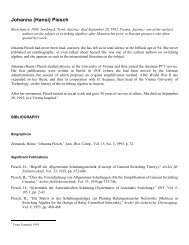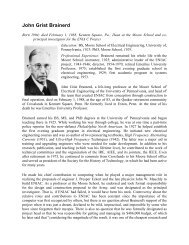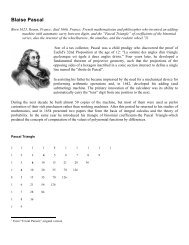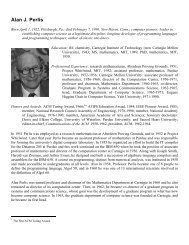John Vincent Atanasoff - Walden Family
John Vincent Atanasoff - Walden Family
John Vincent Atanasoff - Walden Family
Create successful ePaper yourself
Turn your PDF publications into a flip-book with our unique Google optimized e-Paper software.
<strong>John</strong> <strong>Vincent</strong> <strong>Atanasoff</strong><br />
Born October 4, 1903, Hamilton N. Y; inventor of the <strong>Atanasoff</strong> Berry Computer (ABC) with Clifford Berry,<br />
predecessor of the 1942 ENIAC, a serial, binary, electromechanical, digital, special-purpose computer<br />
with regenerative memory.<br />
Education: BSEE, University of Florida, 1925; MS, Iowa State College (now<br />
University), 1926; PhD, physics, University of Wisconsin, 1930.<br />
Professional Experience: graduate professor at Iowa State College (now University),<br />
1930-1942; US Naval Ordnance Laboratory, 1942-1952; founder, Ordnance<br />
Engineering Corp., 1952-1956; vice-president, Atlantic Dir., Aerojet General Corp.,<br />
1950-1961.<br />
Honors and Awards: US Navy Distinguished Service Award 1945; Bulgarian Order of Cyril and Methodius,<br />
First Class, 1970; doctor of science, University of Florida, 1974; Iowa Inventors Hall of Fame, 1978;<br />
doctor of science, Moravian College, 1981; Distinguished Achievement Citation, Alumni Association,<br />
Iowa State University, 1983; Foreign Member, Bulgarian Academy of Science, 1983; LittD, Western<br />
Maryland College, 1984; Pioneer Medal, IEEE Computer Society, 1984; Appreciation Award,<br />
EDUCOM, 1985; Holley Medal, ASME, 1985; DSc (Hon.), University of Wisconsin, 1985; First<br />
Annual Coors American Ingenuity Award, Colorado Association of Commerce and Industry, 1986;<br />
LHD (Hon)., Mount St. Mary's College, 1990; US Department of Commerce, Medal of Technology,<br />
1990, 1 IEEE Electrical Engineering Milestone, 1990.<br />
Special Honors: <strong>Atanasoff</strong> Hall, named by Iowa State University; Asteroid 3546-<strong>Atanasoff</strong>-named by Cal Tech<br />
Jet Propulsion Laboratory and Bulgarian Academy.<br />
Advent of Electronic Digital Computing 2<br />
Introduction<br />
I am writing a historical account of what has been an important episode in my life. During the last half of the<br />
1930s I began and, later with Clifford E. Berry, pursued the subject of digital electronic computing. Included<br />
were my conceptions of computing, and the construction both of a prototype and of what I later called the<br />
<strong>Atanasoff</strong> Berry Computer (ABC), to honor the memory of Dr. Berry's extraordinary competence. But my<br />
contacts with computing began much earlier.<br />
The year 1913 made an impression on my mind because so much seemed to happen then. My family lived in a<br />
new house in Polk County, Florida on the premises of a phosphate mine where my father was an electrical<br />
engineer. Early that year, my father decided that his position required him to have a better slide rule than the<br />
one he had. Now, my father did not really need that new slide rule. So the new slide rule was left for me, with<br />
1 Presented by President George Bush<br />
2<br />
Adapted by J. V. <strong>Atanasoff</strong> from his original manuscript submitted to Annals of the History of Computing, 1983.
its book of instructions. That slide rule was my meat. In two weeks or thereabouts, I could solve most simple<br />
problems with it.<br />
Can you imagine how a boy of nine-plus, with baseball on his mind, could be transformed by this knowledge<br />
Baseball practice was reduced to zero and a stern study of logarithms was substituted. By the age of ten I<br />
became an expert in computing logarithms and many other mathematical and scientific problems.<br />
Early in high school, I decided to study theoretical physics as my life's work. However, at the University of<br />
Florida I studied Electrical Engineering, since it was the most theoretical course given.<br />
In September 1925, I started my graduate work in mathematics at Iowa State College (now University) at Ames,<br />
Iowa.<br />
In the period between 1925 and 1928, I taught mathematics at Iowa State College, and continued graduate work<br />
in mathematics and physics. I received a master's degree in mathematics in 1926 at Iowa State College. In<br />
March 1929, I went to the University of Wisconsin to continue my work for the doctorate. I received my PhD in<br />
physics in July 1930. My thesis was titled The Dielectric Constant of Helium.<br />
This was my first experience in serious computing. Such calculations required many weeks of hard work on a<br />
desk calculator such as the Monroe, which was all that was available at the time. I was also impressed that the<br />
process of approximating the solution of partial differential equations required a great many calculations, a fact<br />
that ultimately motivated my work in automatic computing.<br />
After receiving my doctorate, I returned to Iowa State College where I became assistant professor of<br />
Mathematics. There I gave increased attention to the International Business Machines equipment located in the<br />
statistics department. While this equipment did not permit the mathematical dexterity of the Monroe, it<br />
nevertheless represented the largest calculator of the day.<br />
As the only person in theoretical physics at ISU, I did not have much competition. I was soon made assistant<br />
professor of both mathematics and physics and then, not too much later, an associate professor in both<br />
departments. At about that time (1934), I commenced to give attention to the formal process of approximating<br />
the solution of partial differential equations.<br />
State of the Computing Art<br />
As I came to feel the basic need for more powerful means of computing, I examined, in more detail, the types of<br />
apparatus that were available. I soon determined that computers could be divided into two classes, analog and<br />
digital.<br />
In analog computers, a number is represented by a physical quantity in the machine as measured by some<br />
system of units. A digital computer also requires some entity to represent numbers. Here, however, the<br />
representation is not a simple one-to-one relationship, but is determined by a kind of algorithm called the<br />
Hindu-Arabic number system. While historically this system used numbers to the base ten, we intend no such<br />
restriction, for in theory any whole number greater than unity can be used as the base. My own device and most<br />
modern computers use the base two.
It seemed very clear to me that the advantages of the analog approach had been largely explored and found<br />
wanting, except in some special cases not requiring relatively high accuracy. For most of the purposes of<br />
technology and science, we were left with a digital approach. But to make this fully effective would require a<br />
new and original art.<br />
I thought I knew how a computer should work. First, the computer would have to add and subtract, and later,<br />
one could expand these operations into multiplication and division. At the time, I wondered if anyone had<br />
devised a definition of multiplication that was not based on addition, but the four elementary operations of<br />
arithmetic are interrelated and all computing theoreticians have had to go along with that fact. From the start, I<br />
was interested in carry-over; it is the crux of the digital method.<br />
What are the characteristics with which the digital numbers are to be represented In those days I had little<br />
precedent as to the architecture of a new digital computer of a larger size, that is, capacity. The only attempt at a<br />
machine of sufficient capacity for my purposes was the differential analyzer, an analog device which, as I have<br />
said, did not seem promising. In simple computers and even in the tabulators, the medium of representation was<br />
always mechanical, often the rotation of a shaft, and I must admit that I was inclined to follow this precept.<br />
Even at this early stage, the principal other medium that occurred to me was an electrical state of a circuit. I had<br />
studied electrical engineering and physics, and I had also studied and experimented with electronics, then in its<br />
infancy. So it was perhaps natural that my mind turned to this medium in which I had my greatest expertise.<br />
At an early point in my thinking about digital computers, I commenced to think about the effects of a change in<br />
the base of the number system. Now I had to visualize how a change in base would affect computing structures.<br />
At that time, I had only a very vague idea of a computing machine. I hoped that the nature of the arithmetic for<br />
the various bases would indicate which one would be most advantageous for a computer. These thoughts led to<br />
a conclusion which has stood the test of time.<br />
In looking over the 1936 art in computing, I had become convinced that a new computer should provide for a<br />
much larger retention of data. Almost from the start, I called this “memory.” The word seemed natural to me, as<br />
I suppose that it did to others, since it is still in use today in a wide field including computers.<br />
I now continue with a quotation from my transcript of testimony which I gave in federal court on 1971 June 15:<br />
“Well, I remember that the winter of 1937 was a desperate one for me because I had this problem and I<br />
had outlined my objectives but nothing was happening, and as the winter deepened, my despair grew<br />
and I have told you about the kinds of items that were rattling around in my mind and we come to a day<br />
in the middle of winter when I went out to the office intending to spend the evening trying to resolve<br />
some of these questions and I was in such a mental state that no resolution was possible. I was just<br />
unhappy to an extreme degree, and at that time I did something that I had done on such occasions-I don't<br />
do it anymore-I went out to my automobile, got in and started driving over the good highways of Iowa at<br />
a high rate of speed.<br />
“I remember the pavement was clean and dry, and I was forced to give attention to my driving, and as a<br />
consequence of that, I was less nervous, and I drove that way for several hours. Then I sort of became<br />
aware of my surroundings. I had, of course, been aware of the road before, but then I became aware of<br />
where I was and I had reached the Mississippi River, starting from Ames and was crossing the<br />
Mississippi River into Illinois at a place where there are three cities, one of which is Rock Island.
“I drove into Illinois and turned off the good highway into a little road, and went into a roadhouse there<br />
which had bright lights. It was extremely cold and I took my overcoat. I had a very heavy coat, and hung<br />
it up, and sat down and ordered a drink, and as the delivery of the drink was made, I realized that I was<br />
no longer so nervous and my thoughts turned again to computing machines.<br />
“Now, I don't know why my mind worked then when it had not worked previously, but things seemed to<br />
be good and cool and quiet. There were not many people in the tavern, and the waitress didn't bother me<br />
particularly with repetitious offers of drinks. I would suspect that I drank two drinks perhaps, and then I<br />
realized that thoughts were coming good and I had some positive results.<br />
“During this evening in the tavern, I generated within my mind the possibility of the regenerative<br />
memory. I called it 'jogging' at that time. I'm thinking about the condensers for memory units, and the<br />
fact that the condensers would regenerate their own state, so their state would not change with time....<br />
During that same evening, I gained an initial concept of what is called today the 'logic circuits.' That is a<br />
non-ratcheting approach to the interaction between two memory units, or, as I called them in those days,<br />
‘abaci.’”<br />
During that evening in the Illinois roadhouse, I made four decisions for my computer project.<br />
• I would use electricity and electronics as the media for the computer;<br />
• In spite of custom, I would use base-two numbers (binary) for my computer;<br />
• I would use condensers for memory, but “regenerate” to avoid lapse;<br />
• I would compute by direct logical action, not by enumeration.<br />
I am now amazed and pleased to find that each of my four decisions relates to structures that are in use in modern<br />
computers.<br />
It is true that I did not invent the modern dynamic memory but this memory uses capacitors (condensers) for<br />
memory, and the refresh cycle directly derived from my jogging or regenerative ideas.<br />
So far, the work on the computer had been done by me in my spare time. Since the trip to Illinois, I had used<br />
more than a year working mostly on jogging and logic circuits for adding and subtracting. I now felt much more<br />
confident that the project would be a success and I knew that I could not go on alone. So, early in the spring of<br />
1939, I made an application for a grant from the dean of the graduate school. I planned to hire an assistant and<br />
to have a small budget for materials and shop work.<br />
In selecting an assistant, I felt that I should choose an electrical engineer, since most students entering graduate<br />
work in physics did not have the mechanical or electronic skill. Soon after having these thoughts, I met Dr.<br />
Harold Anderson, a professor of electrical engineering, on the sidewalk in the center of the campus and told him<br />
of my need. He already knew of my interest in computers, and he answered in a moment, “I have your man-<br />
Clifford Berry.”<br />
We started actual work at the beginning of the fall quarter of 1939. Our first effort was to try to prove the<br />
feasibility of this new method of computing that I had developed using theory only.<br />
The Prototype Computer
Even before the fall quarter had begun, Clifford had studied my plans and we were soon involved in a<br />
discussion of how we should proceed. We both agreed that the theoretical aspect of these plans, however<br />
necessary it had been, would have to be reduced to practice. Each portion of my design would have to be built,<br />
examined and fully tested. In the end, we would compose these parts to form a prototype of a computer to see if<br />
the portions would co-act as I had planned. There were parts of the whole that were not fully designed and we<br />
would have to devise them and bring them to fruition.<br />
As I have said, I chose condensers (or capacitors) as the element for memory, because a condenser can give a<br />
good voltage to actuate a vacuum tube, and because the vacuum tube will give enough voltage to recharge the<br />
condenser.<br />
We next had to study how condensers would operate as memory elements, and we soon learned that almost any<br />
condenser would work. We selected paper capacitors of about 0.0015 microfarads capacity.<br />
I suppose the reader will have gathered that I was delighted with the concept of jogging. Jogging is reminiscent<br />
of the little boy going to the grocery store and reciting, “a dozen eggs, a pound of butter,” over and over, hoping<br />
to arrive at the store before his memory has failed. Jogging may be employed when a memory element has two<br />
states and when they deteriorate over time, we can cause it to pass from one state to the other.<br />
In the 1930s vacuum tubes were the only active element available for electronics. It was hard to get a lowvoltage,<br />
direct-current source, and so we wished to use alternating current for our tubes. This limited us to<br />
heater type tubes. The only objection was that the heater types used much more power for the heat source.<br />
Almost as soon as the prototype was completed, it began to work very well. Our visitors who understood what<br />
was going on were surprised to find so much structure giving additions and subtractions that were correct. Of<br />
course, our explanation to them had to cover base-two number theory.<br />
There is little doubt that the prototype, which was the first electronic digital computer, was completed near the<br />
end of 1939. My memory said November 1939. Much later, during cross examination in court, counsel for<br />
defense (Sperry-Rand) showed me material which purported that this was not until early in 1940. In re-cross,<br />
material was adduced by counsel for the plaintiff (Honeywell) which showed that the first demonstration was in<br />
October 1939.<br />
The prototype was, of course, a relatively crude device. It could just add and subtract the binary equivalents of<br />
decimal numbers having up to eight places. Nevertheless, Clifford Berry and I regarded this machine as a great<br />
success. It settled many doubts about how an electronic computer should be built:<br />
• The device was digital, not analog like the differential analyzer;<br />
• While the clock system was mechanical, all computing was electronic;<br />
• For the first time, vacuum tubes were used in computing;<br />
• The very advantageous base-2 number system was first used;<br />
• Logic systems were first employed in computing;<br />
• All computation was done in a serial manner;<br />
• Capacitors (or condensers) were used as memory elements;<br />
• A rotating drum memory contained the capacitors;<br />
• What I called jogging (which others now call regeneration or refreshing) was first used in computation.
Clifford E. Berry and I were very pleased to have access to a method of computing with such power. Once our<br />
prototype had proved successful, we both knew that we could build a machine that could do almost anything in<br />
the way of computation.<br />
During the early years, our computer had a title relating to the solution of large systems of linear algebraic<br />
equations. About 1968, I became aware that it would be discussed at length, and, since Berry was dead, I<br />
wanted a title that would honor him for his extraordinary ability and effort in developing this computer.<br />
Accordingly, I renamed it the <strong>Atanasoff</strong> Berry Computer ... the ABC.<br />
In order to get started fast, I decided to take a chance and estimate the size of the machine. I knew a few<br />
dimensions of the various parts that were to go into it. I was repeatedly trying to estimate the number of vacuum<br />
tubes I would need for this digital electronic computer. Arbitrarily, we had decided that it would operate over 30<br />
fields, and so would require 30 add-subtract mechanisms. Without very much figuring, I made an estimate of<br />
the size of the total machine and arrived at roughly the size of an office desk. So, I ordered a lot of angle iron<br />
for the frame. People saw these irons at the back entrance of the physics building and wondered about them. I<br />
heard someone replying to a question, “Oh, <strong>Atanasoff</strong> thinks he is going to make a computer out of those angle<br />
irons.”<br />
At that time, the largest digital computer was the IBM tabulator. The one we had at Iowa State College could<br />
tabulate and sum 40 columns of the 80 that the punched card provided. But we knew there existed machines<br />
which could tabulate and add the full 80 columns, divided into ten fields of eight columns each.... We planned a<br />
machine of 3000 fields of memory, which would in fact calculate at a speed of about 30 times that of the largest<br />
IBM tabulator.<br />
When one starts a new and strange project, one must expect that it will be in financial trouble from the start. I<br />
had received some aid from Iowa State College, and expected and did receive more from time to time.<br />
However, I knew that I should seek some other source for the funds necessary to complete the computer project.<br />
In my requests to Iowa State College, I had used a two-page write-up, but in asking others for help, I needed<br />
something better. During the spring and summer of 1940, I used my spare time to write not only what we had<br />
done, but also what we proposed to do during the remainder of the project. This paper, finished on August 14,<br />
1940, has been reprinted by Brian Randell in his book The Origins of Digital Computers (1982).<br />
I felt that the work we were doing on computers should be patented, and so, at an early stage, I had investigated<br />
the subject of patents at Iowa State College. It seemed clear to me that there was no firm policy on the subject. I<br />
learned that the Iowa State College Research Foundation (ISCRF), whom I consulted concerning a patent<br />
application, did not regard their own patent counsel as adequate for this task. I was referred to Mr. Richard R.<br />
Trexler, a Chicago patent attorney. When ultimately ISCRF and I entered into a contract for the proceeds of a<br />
patent on my invention, they agreed, in principle at least, to use Mr. Trexler as our patent attorney.<br />
No official pronouncement was made on the terms of a contract, or even on the necessity for a contract, until<br />
Dr. Friley, president of Iowa State College, received the letter of March 24, 1941, from President Howard<br />
Poillon of Research Corporation granting $5330, a considerable amount of money in those days. Then, from a<br />
seeming absence of any policy, the situation changed drastically and Iowa State College policy was suddenly<br />
firm. I am still not exactly sure how it all came about, but I have since seen a letter from Dr. Friley to ISCRF<br />
saying that Iowa State College should hold onto rights to the patent on my invention. I very soon heard from
ISCRE. The first words came to me verbally; in substance, I would not be allowed to use the grant until I signed<br />
a patent contract with ISCRF. I signed the contract in July 1941.<br />
At the time I first contacted Trexler (August 6, 1940), I was finishing my manuscript on “Computing Machines<br />
for the Solution of Large Systems of Linear Algebraic Equations,” and I supplied him with a copy. This did not<br />
satisfy Mr. Trexler, so with some help from me, he drew up a rather extensive specification covering the details<br />
of the patent, and together we directed a draftsman in making the patent drawings.<br />
At this state in my scientific career, I usually attended the winter meeting of the American Association for the<br />
Advancement of Science, which in those days was scheduled between Christmas and New Year's. So, late in<br />
1940, I turned my car eastward with my family and after other activities, on December 26 I attended the<br />
meetings in Philadelphia for three days. My interests were rather wide, and I frequently moved between the<br />
sessions of the various societies which would meet with the AAAS. There were, of course, no papers on<br />
computing in the modern sense, but I was interested in calculation in general. As a consequence of this, I visited<br />
what I clearly remember was a more than ordinarily dusty, chalk-filled classroom assigned to Dr. <strong>John</strong> W.<br />
Mauchly for giving a paper on an application of a harmonic analyzer, which he had constructed, to some<br />
weather phenomena. After the paper was over, I advanced to the podium.<br />
He was very enthusiastic about his analog electrical system for doing Fourier transforms, which had been the<br />
subject of his paper. We talked for most of an hour in this first meeting. In the end, we shook hands and<br />
promised to write.<br />
Dr. Mauchly made good on his promise to write. My files do not have his first letter, but they do have a letter<br />
from me dated January 23, 1941, answering him and inviting him to come and see me. Mauchly was well<br />
pleased with my invitation and there were a succession of letters between us. My memory is that he arrived<br />
about dark on Saturday, June 14, 194 1, accompanied by his young son Jim.<br />
My memory is very clear that he first saw the computer with his son and my family. There was no one else<br />
around, this being Sunday, and this checks with his letter saying he might spend Friday at Iowa City. The<br />
computer was covered with a sheet to prevent dust from settling on it, but I quickly removed this obstruction<br />
and he saw the ABC for the first time. The machine was in process of construction at this point.<br />
I believe that Dr. Mauchly and his son left Ames early on Friday, June 20. Meanwhile, two-thirds of our waking<br />
time was spent talking about computers. He read my manuscript and would have liked to take a copy home with<br />
him, but I did not allow him to do that. He read all parts of this description of our machine and discussed it with<br />
me. Sam Legvold was a graduate student of mine working on another of my projects in a room next to the<br />
computer. Much later, he told the federal court in Minneapolis of Mauchly having his coat off and working with<br />
the machine, when I was otherwise employed. Mauchly took the manuscript to my home with him, and he took<br />
notes on white bond paper which I gave him, at his request.<br />
Mauchly and I had a very cordial relationship while he was at Ames, and after he left we still corresponded,<br />
though at less frequent intervals. On September 30, 1941, he wrote a letter to me which contained the question,<br />
“. . . would the way be open for us to build an '<strong>Atanasoff</strong> Calculator' (à la Bush analyzer) here” In my answer<br />
of October 7, I had to tell him:
Our attorney has emphasized the need of being careful about the dissemination of information about our<br />
device, but it does require that we refrain from making public any details for the time being. It is, as a<br />
matter of fact, preventing me from making an invited address to the American Statistical Association.<br />
On December 7,1941, the Japanese bombed Pearl Harbor and the US was involved in that terrible holocaust.<br />
The future of everyone had to be adjusted to meet this emergency. Soon it became evident that Berry would be<br />
drafted unless he were engaged in a war-related project. Our computer work did not have such a preferred<br />
status, and although I did what I could to get him deferred, the draft board had never heard of our project. As a<br />
result, Mr. Berry started to look for a position for which he could be deferred. He was so able that he quickly<br />
found a suitable position with Consolidated Engineering Corporation of Pasadena, Calif. He married my<br />
secretary, Jean Reed, and on July 1, 1942, he left Iowa State College.<br />
During the spring and summer of 1942, I continued to work with the ISCRF and Mr. Trexler to get the patent<br />
under way. There always seemed to be some reason why it should be put off, however, and put off it was. The<br />
patent was never applied by Iowa State College, probably due to short-term financial considerations.<br />
US Naval Ordnance Laboratory (1942-1948)<br />
I began work at the Naval Ordnance Laboratory (NOL) late in September. The NOL was the research laboratory<br />
of the Bureau of Ordnance. It had responsibility for depth charges, and mines and various other projects, as<br />
assigned. Historically, it had been located in the US Naval Gun Factory, beside the Anacostia River, and there it<br />
remained until the war was over and a new laboratory was constructed north of Washington, D.C., at White<br />
Oak, Md.<br />
Although acoustics had not been one of my particular fields of interest, I was a theoretical physicist, and so I<br />
was put in charge of acoustical testing of mines for the Navy Ordnance Laboratory.<br />
My first objective was to get acquainted with the subject of acoustics. My next objective was to acquire a staff. I<br />
was able to get the services of David Beecher. He had not been my major graduate student (at Iowa State<br />
College) but I knew him well, and he had on occasion, worked on the ABC. Later I was able to get both Dr.<br />
Herman Ellingson, who was on the staff of Luther College in Decorah, Iowa, and my former major student,<br />
Sam Legvold. The rest of my staff came from various other sources.<br />
Although I do not have the date, I think that early in 1943 I was seated at my desk in my noisy, dirty space in<br />
Bld. 184, when I felt someone approaching me from the right. It was Dr. Mauchly. By some means, he had<br />
become attached to the NOL, his security clearance was satisfactory, and somehow he attached himself to my<br />
staff. The exact basis of his employment with NOL was never known to us. I introduced him to my superior, but<br />
he had no more knowledge than I. I did not know how much money he received for his consulting services and I<br />
was too busy to find out. He said he was still employed by the Moore School, but he came back once or twice a<br />
week. At first, I planned various things for him to do; later, I attached him to Dr. Ellingson's statistical group. I<br />
do believe, however, that every time he came in, he stopped by to see me briefly.<br />
One such occasion, he told me that he and J. Presper Eckert had devised a new way to compute. I remember that<br />
I was very busy, but I asked him to tell me about it. His reply was simple: “I cannot, the subject is classified.”
The visits of Mauchly continued sporadically until the end of the war. On August 30, 1944, both Mauchly and<br />
Eckert visited me in the Gun Factory. I believe that at least Eckert did not have proper security clearance for the<br />
area and so they were escorted. They had arranged through the Army and the Navy to obtain my services on<br />
quartz transducers. Although I agreed to help them, they filled their needs elsewhere. This was the only time I<br />
ever saw J. Presper Eckert.<br />
In a period from September, 1942 until the war ended, I was in Ames every few months, and I took the time to<br />
see some member of Iowa State College and discuss the prospect of filing a patent application on our work on<br />
computers. At various times, I also wrote to Counselor Trexler and to the ISCRF. During the first year or two, I<br />
really believed that a patent would be applied for. Much later, Mr. Trexler said he had never been authorized to<br />
proceed.<br />
I have in my files an Iowa State College interoffice memo without signature, written, I believe, by Dean R. E.<br />
Buchanan, of Iowa State College, and it is concerned with the patent situation. The date was June 26, 1948, but<br />
I did not see it for perhaps twenty years. The author speaks of seeing me at the NOL, and I do remember seeing<br />
Dean Buchanan at about that time. He speaks of “<strong>Atanasoff</strong>'s saying that the computer was probably largely<br />
obsolete.” This was clearly incorrect; I spoke, rather, of the need for moving rapidly if anything was to be<br />
salvaged from our work. The memo gives no explanation of the delay in executing the patent contract between<br />
Iowa State College and me.<br />
About September 1945, while I was attending a staff meeting at the Gun Factory, my superior, Dr. L. H.<br />
Rumbaugh, told us that the Bureau of Ordnance was going to build a computer. Of course the research<br />
department would do the work. It was over three years since I had left computing at Iowa State College, and I<br />
had not spoken of this part of my history; it was known, however, and so I was selected to head the project.<br />
Dr. <strong>John</strong> Mauchly came to see us for the first time in several months. In the last years of his life, he claimed that<br />
on this occasion I asked him how to build a computer. I do not remember doing this and do not believe I did; in<br />
any case, I do remember that as always we talked of many things but I heard nothing from him about<br />
computers.<br />
The computer project seemed to be doing very well except for understaffing, but in a short time my superior and<br />
I were called to the office of the chief of research of the Bureau of Ordnance and we were told that the Bureau<br />
wished to discontinue this project. As is usual in such cases, no basic reason was given. After the conclusion of<br />
the computer project, Dr. <strong>John</strong> Mauchly no longer came to the NOL and I saw him again only once, at a much<br />
later date, when he came to my house with Laurence B. Dodds, Counsel for Sperry-Rand.<br />
The Ordnance Engineering Corporation (1952-1961)<br />
Early in 1952, I was thinking of the types of experience I had encountered. I was 48 years old and I knew that if<br />
I wanted to be involved in private enterprise, the time had come; one of my friends, in fact, had told me that I<br />
was already too old. However, with a few firm friends, I incorporated The Ordnance Engineering Corporation<br />
(TOEC) in the state of Maryland.<br />
During the first years of this corporation, we rented space in Rockville, Md. On June 15, 1954, we received a<br />
visit from Mr. A.J. Etienne, who was a patent attorney for International Business Machines Corporation. As<br />
soon as I learned that we were going to discuss patents, I called David Beecher, our vice president, into the
conference. Mr. Etienne announced his purpose by saying in substance, “If you will help us, we will break the<br />
Mauchly-Eckert computer patent; it was derived from you.”<br />
I hesitated to reply to Mr. Etienne. I was looking back over the years that had passed since Mauchly had told me<br />
(in 1943) that he and Eckert had invented a “new method of computing, different from yours,” and I had<br />
believed him. This was the first substantial item to the contrary that I had encountered. I did not know of the<br />
patent to which Mr. Etienne was referring, that is, the Regenerative Memory patent 2,629,827, issued the<br />
previous year (1953). (The ENIAC patent, applied for in 1947, was not issued until 1964.)<br />
I remember wondering if Etienne was correct.<br />
In 1956, we sold the corporation to Aerojet General Corporation, with principal offices in Azusa, Calif. After<br />
our incorporation into Aerojet General (AGC), we were called the Atlantic Division. In 1959, I was made vice<br />
president of AGC and managed the Atlantic Division.<br />
As the US changed to peace conditions after the Korean War, I used my experience in computing to shift the<br />
activity of the Atlantic Division toward the invention and manufacture of automatic equipment for parcel<br />
handling and sorting. By this time, I had found being a “corporation man” not to my liking. Accordingly, I<br />
resigned as vice president of Aerojet General Corporation early in 1961.<br />
During these years, I was well aware of the growing interest in computing. Even before Mr. Etienne's visit, I<br />
knew that certain companies were making inquiries of anyone skilled in the art, including Dr. Clifford E. Berry<br />
and myself.<br />
From time to time during the twenty-plus years that had elapsed after Berry had left Ames, I visited Clifford and<br />
Jean in their home in Altadena. Nearly every time that my business called me to California, I took an evening to<br />
spend with them and their family. During, say, the first two-thirds of this period, I was told of his interest in and<br />
success with his work, and of his rapid advancement with his company. I do not know exactly when this picture<br />
changed; perhaps by 1960, though, Clifford, while still excited with his work, was less satisfied with the<br />
position he held with his company. I also noticed a slight cynicism in his general attitude, which I took to be a<br />
natural consequence of aging.<br />
Late in 1963, I was overwhelmed to get a letter from Jean Berry, saying that Clifford had resigned his position,<br />
taken a place with a company in Long Island, and had died one night at his apartment.<br />
In late 1967, still feeling unhappy over his death, I made a personal investigation of it. I located his apartment<br />
and talked with the man who had first found him. I also visited the police of the county, since his death was not<br />
natural; he had been found in bed with a plastic sack over his head but with his bedclothes smoothly over his<br />
arms, which were by his sides. An autopsy revealed that his brain plasma had 0.12% alcohol content, which<br />
would have permitted him to drive a car in some jurisdictions. He had been taking Dilantin because of recent<br />
epilepsy, and so his blood and brain were carefully examined for this and other drugs; none was found. Suicide,<br />
said the authorities.<br />
Preliminaries of Litigation
On April 26, 1967, I was visited by Mr. Allen Kirkpatrick, a patent attorney of Washington, who represented<br />
Control Data Corporation (CDC). He had learned of me by reading a book, Electronic Digital Systems, by R. K.<br />
Richards. Mr. Richards had seen our computer with Clifford Berry. I soon was told that Sperry-Rand<br />
Corporation was suing CDC, and was given a quick summary of the issues. Later, Mr. Kirkpatrick furnished me<br />
copies of the patents involved, and suggested that I scan their claims to find any that were developed in my own<br />
work.<br />
During his April visit, Mr. Kirkpatrick also told me that Sperry-Rand was going to sue Honeywell (my notes<br />
say that the Honeywell suit was begun on May 26, 1967). More specifically, Honeywell was to be sued by<br />
Illinois Scientific Developments, Inc. (ISD), a subsidiary of Sperry-Rand. Kirkpatrick gave me some<br />
information on the Honeywell suit as well. At about this time, I also was contacted by Henry Hanson, D. Dennis<br />
Allegretti, Charles G. Call, patent attorneys, and Henry Halladay, trial attorney, all of whom represented<br />
Honeywell in that case. I agreed to do consulting work for both CDC and Honeywell.<br />
Then, not long after Mr. Kirkpatrick came to see me, I was approached by attorneys George Eltgroth, Norman<br />
Fulmer, and H. Mial Dustin of General Electric. Fulmer had been at Iowa State College and had actually<br />
worked on the ABC. When these men visited me, I had partially read the ENIAC patent and I knew that certain<br />
claims were derived from my work.<br />
Law is not my specialty, although I had spent some 2000 hours studying patent law over the years, and I append<br />
the following from hearsay. Sperry-Rand, having acquired certain patents from Mauchly and J. Presper Eckert,<br />
in particular the ENIAC patent 3,120,606 and the Regenerative Memory patent 2,629,827, felt that they had a<br />
basic patent control of the computing machine field, and sought to levy royalties on those companies in<br />
violation of the claims of their patents. I have heard these royalties were estimated at one billion dollars, all told.<br />
To begin this legal process, Sperry-Rand chose to sue CDC over the Memory patent and Honeywell over the<br />
ENIAC patent, since both CDC and Honeywell had resisted paying royalties; Honeywell counter-sued for antitrust<br />
violation and became the plaintiff in a combined ENIAC suit.<br />
The Memory patent had been applied for in 1947 and was issued in 1953. The ENIAC patent had been applied<br />
for in 1947 and was issued in 1964. For some legal reasons and/or the desire of judges, the suit of Sperry-Rand<br />
vs. CDC was to be held in Baltimore and the suit of Honeywell vs. Sperry-Rand was planned for Minneapolis.<br />
It was soon clear to everyone that these lawsuits would become monumental in computing machine history and<br />
would take some years before coming to trial.<br />
After learning from the attorneys of Honeywell and CDC how seriously they regarded the litigation, I made a<br />
careful search of my papers. I had just moved into a new house and had a collection of boxes which had not<br />
been opened for many years. Some of these had been with me and some had been in storage. In two of these<br />
boxes, I found my files for the computing machine. These represented hundreds of items which were later used<br />
in the litigation.<br />
I was interested, but slightly amused, that I had found myself in the mesh of the federal court system of our<br />
nation. I have always been intrigued by the law and our patent system, but jurisprudence is far removed from<br />
the fields in which I have labored. Watching these two cases unfold in our federal courts gave me a little deeper<br />
feeling of how man gets along with man.
Formal Litigation<br />
We use the term “formal litigation” for the two processes, deposition and trial, by which evidence is produced<br />
for the judge (or jury) to use in reaching a verdict. This part of litigation is the major part; in important cases,<br />
the records become voluminous. In the matter of computer litigation being considered here, there were only two<br />
cases at that time, the Memory case and the ENIAC case; even so, the legal documents numbered in the<br />
thousands.<br />
In the early years while the trials were pending, there were many depositions, including those of the principal<br />
witnesses and of many other witnesses who would not attend the trial. I was deposed once for each of the two<br />
trials. While my first deposition, on the Memory case, was rather short, the second, on the ENIAC case, lasted<br />
approximately two weeks, beginning on November 11, 1968. In both cases, Dodds was counsel for Sperry-<br />
Rand.<br />
Among the witnesses deposed (of personal interest to me) were myself, both trials; Mauchly, both trials; J.<br />
Presper Eckert, both trials; Lura Meeks <strong>Atanasoff</strong>, both trials; and Sam Legvold, both trials; as well as many<br />
other people. Clifford Berry was not alive at the time of the deposition, but in a way a letter he wrote to R.K.<br />
Richards 1 on March 22, 1963, quoted again and again in the trial, served as a statement by him of the situation<br />
when Mauchly came to Ames.<br />
The deposition of Dr. <strong>John</strong> W. Mauchly October 11, 12, 13, 1967, was taken on behalf of the defendant, CDC,<br />
in the suit by Sperry-Rand on the so-called Memory patent 2,629,827 and certain other patents.<br />
Mauchly spoke of his visit to see our machine. He spoke of being cordially received, but hinted that no one was<br />
willing to tell him all about the machine. He claimed that nothing worked except the motor. There was no<br />
demonstration of the action of the machine, he asserted.<br />
He said he had no time with the machine: perhaps half-an-hour. Later: perhaps 1½ hours.<br />
He saw one cylinder of condensers, he said. He learned that memory was retained by the use of regeneration,<br />
but said he was not told how the regeneration worked.<br />
Both Sam Legvold (a former student and employee) and myself, on deposition and in trial testimony, stated<br />
under oath (and Berry in his 1963 letter to Richards corroborated), that when Mauchly visited the computer<br />
laboratory at Ames, he was given the full details of the project and he was given much more than anyone else;<br />
that he was given the complete current operational test of the computer; that he spent a length of time with the<br />
machine in excess of 16 hours, took his coat off to work on the machine in his shirtsleeves and held certain parts<br />
of the machine in his hands; and that he saw our current memorandum (August 1940) on the machine and took<br />
notes.<br />
Honeywell versus Sperry-Rand<br />
1 See Biography of Clifford Berry.
This trial was held in the federal court at Minneapolis, with judge Earl R. Larson presiding. It began June 1,<br />
1971. Knowing that I would be an early witness, I went to Minneapolis on June 7. For the moment, I spent my<br />
time listening to the court testimony and having private briefings by counsel for Honeywell.<br />
This being my first testimony in a federal court, I took it very seriously. The total record associated with my<br />
presence on the witness stand was 1,338 pages long. Of this, the major portion was describing the computer;<br />
one of the last parts related to the period when Mauchly was working for me at the NOL, and I have covered<br />
that in my historical summary of the case.<br />
It was late on Friday, June 25, 1971, and I was through testifying, after nine days on the witness stand. I took<br />
time to say good-bye to some of the staff, including the court reporters, who had stood by and prepared good<br />
copy in spite of technical words and low tones.<br />
Then I looked over at the table for Sperry-Rand and there was (Counselor) Mr. Ferrill, alone, picking up some<br />
papers. I do not want to be lacking in manners, and so I advanced with my hand extended to say good-bye to<br />
him. I find it hard to describe what happened for the next few seconds; I felt that I was looked over in some<br />
minute detail. In the end, though, he reluctantly took my hand. He did not look happy; perhaps he knew better<br />
than I of the effects of my testimony.<br />
The trial in the ENIAC case ended on March 13, 1972; it had taken 135 days or parts of days. A total of 77<br />
witnesses were heard. The total trial transcript was 20,667 pages. After the trial ended, judge Larson took some<br />
time to reach his decision, which was finally issued on October 19, 1973. Of course, this was a decision that<br />
should have received major press coverage; the press, however, was occupied with other matters, because<br />
October 20 was the date of the Saturday Night Massacre of Watergate fame.<br />
The decision itself comprised 248 pages of legal paper, with an appendix of 60-plus pages. The judge found 17<br />
specific claims on the ENIAC patent invalid on a variety of grounds, including two claims taken to be<br />
representative of the subject matter derived from me by Mauchly and Eckert. He found the entire patent invalid<br />
on three grounds unrelated to actual inventorship: public use, sales, and published disclosure, all dated more<br />
than one year prior to the ENIAC patent filing date of June 26, 1947. Of greater significance to me is the fact<br />
that he also found the entire patent invalid on the ground of derivation from my prior electronic digital<br />
computer. I quote relevant passages from judge Larson's decision:<br />
“The subject matter of one or more claims of the ENIAC was derived from <strong>Atanasoff</strong>, and the invention<br />
claimed in the ENIAC was derived from <strong>Atanasoff</strong>. “<br />
“Eckert and Mauchly did not themselves first invent the automatic electronic digital computer, but<br />
instead derived that subject matter from one Dr. <strong>John</strong> <strong>Vincent</strong> <strong>Atanasoff</strong>.”<br />
“Between 1937 and 1942, <strong>Atanasoff</strong>, then a professor of physics and mathematics at Iowa State College,<br />
Ames, Iowa, developed and built an automatic electronic digital computer for solving large systems of<br />
simultaneous linear algebraic equations.”<br />
“This breadboard model machine, constructed with the assistance of a graduate student, Clifford Berry,<br />
permitted the various components of the machine to be tested under actual operating conditions.”
“The discussions Mauchly had with both <strong>Atanasoff</strong> and Berry while at Ames were free and open and no<br />
significant information concerning the machine's theory, design, construction, use or operation was<br />
withheld.”<br />
“Prior to his visit to Ames, Iowa, Mauchly had been broadly interested in electrical analog calculating<br />
devices, but had not conceived an automatic electronic digital computer.”<br />
“Eckert and Mauchly did not themselves first invent 'the automatic electronic digital computer,' which<br />
Sperry-Rand and ISD contend to be the subject matter of the ENIAC patent, but instead derived that<br />
broad subject matter from Dr. <strong>John</strong> V. <strong>Atanasoff</strong>, and the ENIAC patent is thereby invalid.”<br />
After thus spelling out the conduct of Mauchly and Eckert in regard to me and my work, judge Larson presented<br />
the other side of the picture, including a lack of action by me, and found Honeywell not entitled to antitrust<br />
damages for willful and intentional fraud on the Patent office.<br />
In addition to his findings on the derivation of the ENIAC from me, judge Larson now ruled that the<br />
Regenerative Memory Patent No. 2,629,827 at issue in the CDC case in Baltimore, was derived from me.<br />
Disposition of the Two Cases<br />
Everyone expected that judge Larson's decision would be appealed, but rather quickly it was settled by the<br />
payment of money and an agreement between the parties that each would support the judge's decision of 1973. I<br />
have been told that Sperry-Rand paid $3,500,000, sufficient to reimburse Honeywell for the cost of the trial.<br />
Thus ended this important case.<br />
As to the Computer Memory case in Baltimore, I acted as a witness in it after the ENIAC trial was over. The<br />
trial in that case was active for only a few days; then it was abandoned from lack of interest of principals or<br />
counsel. In 1981, nine years later, some important judge insisted that the case be settled, and so it too was<br />
settled by a contractual agreement, this time between CDC and Sperry-Rand. I was told that a payment of<br />
money was made here also, by Sperry-Rand, but the amount and other terms were not disclosed. The matter was<br />
moot, because the patent had expired.<br />
BIBLIOGRAPHY<br />
Biographical<br />
<strong>Atanasoff</strong>, <strong>John</strong> V., “Advent of 'Electronic Digital Computing,” Ann. Hist. Comp., Vol. 6, No. 3, 1984, pp. 229-<br />
282.<br />
Burks, Alice R., and Arthur W. Burks, The First Electronic Computer: The <strong>Atanasoff</strong> Story, University of<br />
Michigan Press, Ann Arbor, Mich., 1988.<br />
Burks, Arthur W., and Alice R. Burks, “The ENIAC: First General Purpose Electronic Computer,” Ann. Hist.<br />
Comp., Vol. 3, No. 4, 1981, pp. 310-399.<br />
Finerman, A., ed., “The Origins of Modern Computing,” Comp. Revs., Sept. 1990, pp. 449-481.
Larson, E.R., Findings of Fact, Conclusions of Law and Order for Judgment, File No. 4-67 Civ. 138,<br />
Honeywell Inc. vs. Sperry-Rand Corporation and Illinois Scientific Developments, Inc., US District<br />
Court, District of Minnesota, Fourth Division, Oct. 19, 1973.<br />
Mauchly, <strong>John</strong> W., “Amending the ENIAC Story,” Datamation, Vol. 25, No. 11, 1979, pp. 217-219.<br />
Mollenhoff, Clark R., “<strong>Atanasoff</strong>, <strong>John</strong> <strong>Vincent</strong>” in Ralston, Anthony, and Edwin D. Reilly, Jr., Encyclopedia<br />
of Computer Science and Engineering, Van Nostrand Reinhold Co., New York, 1983.<br />
Mollenhoff, Clark R., <strong>Atanasoff</strong>: The Forgotten Father of the Computer, Iowa State Univ. Press, Ames, Iowa,<br />
1988.<br />
Ritchie, David, The Computer Pioneers, Simon and Shuster, New York, 1986, Chapter 6.<br />
Slater, Robert, Portraits in Silicon, MIT Press, Cambridge, Mass., 1987, Chapter 6.<br />
Significant Publications<br />
<strong>Atanasoff</strong>, <strong>John</strong> V., “Computing Machine for the Solution of Large Scale Systems of Linear Algebraic<br />
Equations,” reprinted in Randell, Brian, Origins of Digital Computers: Selected Papers, Springer-<br />
Verlag, Berlin and Heidelberg, 1982, pp.315-336.<br />
UPDATES<br />
<strong>John</strong> <strong>Vincent</strong> <strong>Atanasoff</strong> died June 15, 1995. (MRW, 2012)


